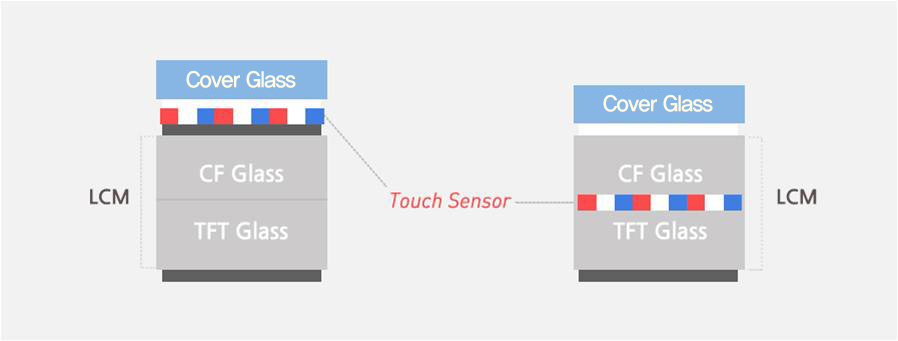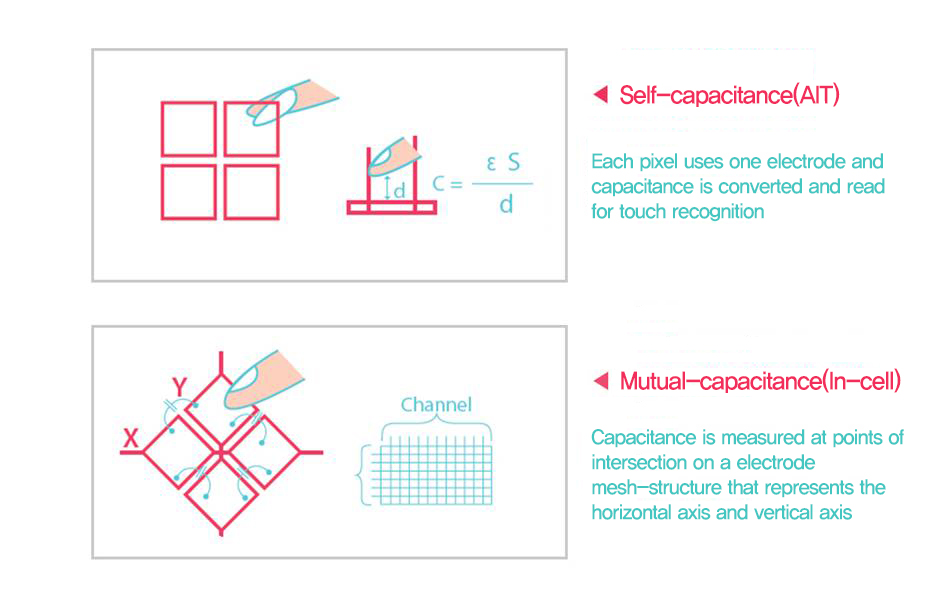 Since the introduction of the smartphone, we no longer use the word 'cellphone'. After all, we use smartphones for much more than merely looking at them and using our fingers to touch them. Technology for the touching of mobile display has continued to develop in order to match how we utilize our smartphones. LG Display is recognized for having revitalized the world of new touch technology by integrating LCD with touchscreen with AIT (Advanced In-cell Touch).
Since the introduction of the smartphone, we no longer use the word 'cellphone'. After all, we use smartphones for much more than merely looking at them and using our fingers to touch them. Technology for the touching of mobile display has continued to develop in order to match how we utilize our smartphones. LG Display is recognized for having revitalized the world of new touch technology by integrating LCD with touchscreen with AIT (Advanced In-cell Touch).
Add on and In-cell Touch Technology
Touch display technology can be categorized by 'Add on' or 'In-cell' according to the location of the touch sensors. Add on is an external solution where the touch sensors are adhered on top of the LCM (Liquid Crystal Module). In other words, a touch screen panel is attached to an LCD. On the other hand, In-cell type touch electrodes are embedded in the display panel so the LCD and the touch screen are unified.
 What are the advantages of integrating LCD and touch sensors? The first advantage is how noticeably thin the display can be. Since a smartphone must be a small enough device to fit in the user's hand, the difference in thickness of the display has a large impact. LCD also reduces the amount of glare from external light so that the user can see the screen clearly even when the they are outside on a bright day. As this, LG Display is able to put out a thinner smartphone with a clearer screen by using In-cell technology.
What are the advantages of integrating LCD and touch sensors? The first advantage is how noticeably thin the display can be. Since a smartphone must be a small enough device to fit in the user's hand, the difference in thickness of the display has a large impact. LCD also reduces the amount of glare from external light so that the user can see the screen clearly even when the they are outside on a bright day. As this, LG Display is able to put out a thinner smartphone with a clearer screen by using In-cell technology.
AIT Puts the World at Our Fingertips!
So we've briefly discussed the Add on and In-cell technologies but what do these technologies have to do with AIT? AIT stands for Advanced In-cell Touch. This refers to a step forward in In-cell touch technology. AIT technology is LG Display's own technology that puts the touch panel inside the LCD and it takes up very little space on the bezel, which reduces the thickness and makes for slim design while providing an improved touch experience.
Let's take a closer look at the reasons behind this advance in the technology. In-cell Touch is a multi-touch capable mutual-capacitance solution whereas AIT is a self-capacitance single-touch solution. In actuality, mutual-capacitance technology, which utilizes touch from multiple fingers, was perceived to be a more powerful technology than self-capacitance, which utilizes touch from only one finger. But AIT created a shift in that ideology as soon as it was developed.
Because of this, LG Display solved the 'one finger recognition problem' attributed to self-capacitance. The key to this was a groundbreaking refinement of the sensors done by dividing the block units of the electrode. Through this innovation, LG Display were able to retain the existing superior sensitivity while producing results as effective as touch using multiple fingers and made touch possible even when the display is submerged in water. The developers were able to analyze each of the fundamentals of this technology and sublimate the strong points.
3 Greatest Attributes of AIT
1. Thinner, Slimmer Design!
Consumers are now using smartphones for much more than just phone calls and texting. The number of queries from mobile phones has now even exceeded that of PCs. So naturally they want even bigger screens with higher resolution. Moreover, since users always have their smartphone in their hands, the ability to grip the device is an important factor to consider when selecting a smartphone.
AIT is exactly the 'thinner, slimmer' product that consumers are looking for. It has been established that a display with AIT technology in it will be a thinner display. A slimmer design presents smartphone designers with much more freedom. A thinner and yet more capable smartphone can now be made that was never possible before.
2. More Competitive Prices!
The process of embedding sensors in the panel with AIT is simpler than adhering the sensors to the LCM as is done with Add on. The manufacturing costs are lower because there is no need for transparent electrode film of adhesives. Also, since there is no need for separate modular processes, the product can be manufactured without the need to cooperate with panel manufacturers and touch screen panel manufacturers.
3. Superior Touch Sensitivity
The demand for a smartphone with stronger capabilities is increasing throughout the world. AIT provides faster response times and increased touch sensitivity. AIT has improved sensitivity because it is created with the application of LG Display's own LFD (Load Free Driving). As thin as the panel is, the reactivity of the display when contacted by a finger is also incredible. The application icons on the display move with such accuracy to the touch that it feels as though the finger is actually touching the icons on the LCD surface. This is a vital part of the user experience.
www.lg.com
























































































